



















|
 |
|
 |

Pontos has access to a wide selection of troops, with Galatians, Thracians & Cappadocians nearby, and if they expand across the Black Sea, numerous Scythian units as well. While being influenced by Macedonian military traditions, Pontos does not have the troops of good enough quality to fight the Diadochoi in the Macedonian manner, and any Pontic general should find other tactics and troops to level the playing field, should Pontos find itself at war with either Makedonia to the west or Arche Seleukeia to the south.
Pantodapoi (Hellenic Native Spearmen)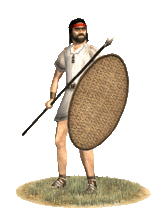 The most basic and numerous of the infantry units used by the non-European Successor States were the Pantodapoi infantry. These men were called from a variety of nationalities and were usually settled in certain areas for garrison duties and the like. There were Jews, Syrians, Cilicians, Persians, Assyrians, Native Egyptians, and many other peoples counted among their number. They are not particularly reliable soldiers, but they are certainly better than their eastern counterparts. They can give a good account of themselves in battle if deployed properly. They wear no armor, and have only a light shield for protection, so most other infantry will slaughter them in droves. They can fend off light cavalry for a time, if need be. The most basic and numerous of the infantry units used by the non-European Successor States were the Pantodapoi infantry. These men were called from a variety of nationalities and were usually settled in certain areas for garrison duties and the like. There were Jews, Syrians, Cilicians, Persians, Assyrians, Native Egyptians, and many other peoples counted among their number. They are not particularly reliable soldiers, but they are certainly better than their eastern counterparts. They can give a good account of themselves in battle if deployed properly. They wear no armor, and have only a light shield for protection, so most other infantry will slaughter them in droves. They can fend off light cavalry for a time, if need be.
Historically, the Pantodapoi were a group of various nationalities that were used as a militia levy and defensive group for towns and villages prone to raiding. While the name is conceptual (meaning, from everywhere), they were a standard fighting force of the day. They were trained rudimentarily, but had enough training to be counted as superior to many militia levies. They had some experience fighting off nomadic raiders, so they can be useful against light troops and some light cavalry.
Hoplitai Haploi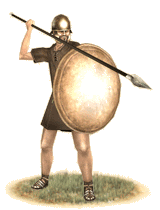 The poorest citizens of the Hellenic and Makedonian poleis fought as a militia roughly organized along the lines of other, more professional hoplite soldiers. They are organized in the phalanx and are quite high quality for militia, due to the dogged Hellenic spirit and fighting tradition. They can be expected to hold a line against most light and medium infantry, though they will be devastated by missile troops, as they have virtually no protection from missiles aside from their shields and the bodies of their compatriots. They are still useful against cavalry as no horse will willingly charge a bristling wall of spear points. Hoplitai Haploi, if used properly, can be an inexpensive and very valuable unit, though they will be outclassed against heavier and more professional troops, they can, if well supported, hold the line far better than one would expect of a militia. The poorest citizens of the Hellenic and Makedonian poleis fought as a militia roughly organized along the lines of other, more professional hoplite soldiers. They are organized in the phalanx and are quite high quality for militia, due to the dogged Hellenic spirit and fighting tradition. They can be expected to hold a line against most light and medium infantry, though they will be devastated by missile troops, as they have virtually no protection from missiles aside from their shields and the bodies of their compatriots. They are still useful against cavalry as no horse will willingly charge a bristling wall of spear points. Hoplitai Haploi, if used properly, can be an inexpensive and very valuable unit, though they will be outclassed against heavier and more professional troops, they can, if well supported, hold the line far better than one would expect of a militia.
Historically, the poorest citizens of any polis and the peasants on the estates of Makedonia were called up in defense of their homeland to fight as militia. They had been used to devastating effect in many ancient battles while forming the second line of battle. They were good and courageous soldiers that fought with a degree of discipline and courage that would not be thought possible of an unprofessional milita. They were not cowards and did not break quickly, but were often annihilated if facing good missile troops or heavier, more professional infantry. Peltastai and other units armed with javelins were particularly devastating to the militia hoplites, due to their lack of protection on the battlefield.
Akontistai (Hellenic Skirmishers)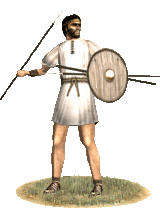 Those unlucky enough to be extremely poor freedmen were pressed into service as psiloi, missile units, and the lowest class of Hellene infantry. The psiloi were divided into three parts: javelineers, slingers, and archers. The javelin-armed psiloi, the akonistai, were ragged peasants armed with javelins and small knives. Their function was simply to throw their missiles and then run as fast as possible to safety behind the hoplitai lines. They were used for skirmishing and to provide a demoralizing hail of missile fire during the grinding battle between the two phalanxes. Never use akonistai in melee except as diversionary fodder or as a flanking force; roles in which they don't excel, but might actually be better than nothing. They have their uses, as their javelins are still sharp and deadly, but they were often used only as light skirmishers or as a last resort in Hellenic armies for obvious reasons. Those unlucky enough to be extremely poor freedmen were pressed into service as psiloi, missile units, and the lowest class of Hellene infantry. The psiloi were divided into three parts: javelineers, slingers, and archers. The javelin-armed psiloi, the akonistai, were ragged peasants armed with javelins and small knives. Their function was simply to throw their missiles and then run as fast as possible to safety behind the hoplitai lines. They were used for skirmishing and to provide a demoralizing hail of missile fire during the grinding battle between the two phalanxes. Never use akonistai in melee except as diversionary fodder or as a flanking force; roles in which they don't excel, but might actually be better than nothing. They have their uses, as their javelins are still sharp and deadly, but they were often used only as light skirmishers or as a last resort in Hellenic armies for obvious reasons.
Historically, akontistai did not play a particularly large role on the battlefield, and weren't normally a particularly decisive force. They were used mainly for their ability to induce an enemy to attack prematurely. They are little more than an annoyance on the open field, but can be deadly if positioned in places where their javelins can be used for maximum effect: on high terrain, on an enemy unit's flank, or atop a city wall.
Gund-î Paltâ (Eastern Skirmishers)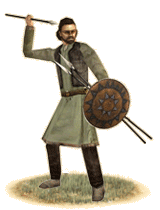 Armed with nothing but a small shield and a handful of javelins these men risk their lives in closing with the enemy with only the lightest of equipment. These men deploy in a cloud before the heavy infantry dashing back and forth to release their deadly missiles. These infantry skirmishers fought in open formations so as to maximize the number of men able to get a throw and minimize the effect of enemy missiles. Lacking armour, training and heavy weapons these light infantry stand no chance if committed to melee. Armed with nothing but a small shield and a handful of javelins these men risk their lives in closing with the enemy with only the lightest of equipment. These men deploy in a cloud before the heavy infantry dashing back and forth to release their deadly missiles. These infantry skirmishers fought in open formations so as to maximize the number of men able to get a throw and minimize the effect of enemy missiles. Lacking armour, training and heavy weapons these light infantry stand no chance if committed to melee.
Historically, most armies of the classical period found use for poorly equipped levies as skirmishers, very often as javelinmen, as these troops required relatively little training and financial investment, relying mostly on widespread natural skills and scant gear, while still providing some useful service.
Sphendonetai (Hellenic Slingers)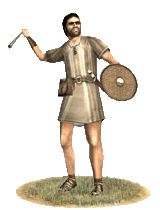 Sphendonetai are the second branch of the psiloi, and are only marginally more useful than their compatriots with javelins. Their sphendonai (slings) can prove deadly weapons, being able to crush bones and armor, and shatter shields from a distance, but they are mainly used to harass and annoy enemy soldiers to force a premature or rash action. Since a sphendone is an easily constructed weapon, and ammo is readily available in Hellas' rocky terrain, Sphendonetai are mostly poor peasants and shepherds that use this weapon to provide a meager amount of protein in their already poor diet or use their weapons to keep predators away from their flocks. Sphendonetai are the second branch of the psiloi, and are only marginally more useful than their compatriots with javelins. Their sphendonai (slings) can prove deadly weapons, being able to crush bones and armor, and shatter shields from a distance, but they are mainly used to harass and annoy enemy soldiers to force a premature or rash action. Since a sphendone is an easily constructed weapon, and ammo is readily available in Hellas' rocky terrain, Sphendonetai are mostly poor peasants and shepherds that use this weapon to provide a meager amount of protein in their already poor diet or use their weapons to keep predators away from their flocks.
Historically, sphendonetai had their uses, they were often used to harass and provoke the enemy forces by causing some casualties and some damage to the enemy's armament, particularly the shields, which were easily dented or cracked by a well slung glande (sling projectile). Alexandros employed his sphendonetai at the battle of Gaugamela to harass the Persian heavy cavalry until they decided to give fight, and then promptly cut them off from the rest of the Persian army, allowing the Hetairoi to cut them to shreds.
Shűbân-î Fradâkhshânâ (Eastern Slingers)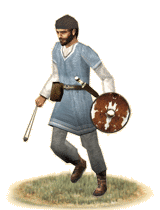 Slings are very easy and cheap to make and, yet, they are a respectable weapon. It is for this reason that they are so prevalent among the poverty-stricken hill tribes of the eastern lands. In battle, slingers are used as light skirmishers, troops with no armour or melee weapons but who rush forward against the enemy to pepper them with stones, only to flee when threatened. The best method of releasing a stone from a sling is by an underhand motion. These missiles can leave the sling in excess of 60 miles per hour. A well trained slinger can hurl a stone as far and as accurately as a good archer. The effect when they strike is nothing short of devastating. Slings are very easy and cheap to make and, yet, they are a respectable weapon. It is for this reason that they are so prevalent among the poverty-stricken hill tribes of the eastern lands. In battle, slingers are used as light skirmishers, troops with no armour or melee weapons but who rush forward against the enemy to pepper them with stones, only to flee when threatened. The best method of releasing a stone from a sling is by an underhand motion. These missiles can leave the sling in excess of 60 miles per hour. A well trained slinger can hurl a stone as far and as accurately as a good archer. The effect when they strike is nothing short of devastating.
Historically, slingers came from the shepherd boys of the highlands who use slings to herd sheep and goats. They stand guard in the upland pastures, and if they see an animal straying, they sling a stone in front of it to ward it back to safety. Ancient hand slings generally consisted of a single long strip of leather or woven wool, with a central "pocket" for the stone. The longer the sling, the greater would be its range. Long-range slings were about 3 feet long.
Toxotai (Hellenic Archers)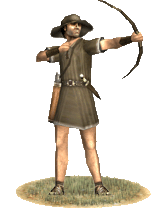 Toxotai are the third branch of the psiloi, the archers of Hellene and Makedonian armies. They are generally from the upper end of the poor and recruited from mountainous regions where the use of the bow is an essential skill to keep one's flock of sheep safe from roving predators. Toxotai are well trained in a manner of speaking, that being that they are using their weapon of choice (often of necessity) from birth. They are decent archers, but are nowhere near as professional as the archers from the east and south. They mostly use the short bow, which means that they are often outgunned by their counterparts from other lands. This reflects their secondary role in a Hellenic army. As most missile units, they will be cut to ribbons in melee, so they should be well protected from enemy ranks. Toxotai are the third branch of the psiloi, the archers of Hellene and Makedonian armies. They are generally from the upper end of the poor and recruited from mountainous regions where the use of the bow is an essential skill to keep one's flock of sheep safe from roving predators. Toxotai are well trained in a manner of speaking, that being that they are using their weapon of choice (often of necessity) from birth. They are decent archers, but are nowhere near as professional as the archers from the east and south. They mostly use the short bow, which means that they are often outgunned by their counterparts from other lands. This reflects their secondary role in a Hellenic army. As most missile units, they will be cut to ribbons in melee, so they should be well protected from enemy ranks.
Historically, the Hellenes did not use archers in any significant fashion. They did not have the composite bows of their neighbors, and their lands were not particularly suited to the cattle and horse farming that supplied the raw material for these bows. Therefore, archers fulfilled the same role as other psiloi: that of long range harassment. The Hellenes and Makedonians had no real tradition of archers and could not recruit any but these shepherds to do this work for them, since they lacked any access to the archers of the east. Most Hellene states relied on Skythian and most importantly Kretan archers to do this for them.
Thanvarę Payâhdag (Persian Archers)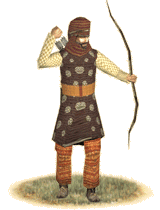 These men are skirmishers only and not inclined to close with enemy troops. These men would have the fully sleeved, long Persian Kapuris tunic. Often brightly coloured these traditional tunics would end just above the knees secured at the waist by a wide woven belt. They would also have a woolen cap, loose trousers and soft felt shoes. They would be armed with the powerful composite bow and a long dagger suitable only for defense. A plain leather quiver would be strung over their back. They would also have a simple woolen cap. These men are skirmishers only and not inclined to close with enemy troops. These men would have the fully sleeved, long Persian Kapuris tunic. Often brightly coloured these traditional tunics would end just above the knees secured at the waist by a wide woven belt. They would also have a woolen cap, loose trousers and soft felt shoes. They would be armed with the powerful composite bow and a long dagger suitable only for defense. A plain leather quiver would be strung over their back. They would also have a simple woolen cap.
Historically, the mainstay of the Parthian infantry were foot archers. These foot archers almost certainly represented the poorer elements of the various infantry levies of Parthia. The tradition of mounted archery in Parthia and the northern steppe peoples makes it almost inevitable that a massed levy would produce significant numbers of foot archers as well. The station usually assigned to these Parthian bowmen is behind the first line of spearmen and forward of them in skirmishing lines. These troops are vital to any armies plan, harassing and confusing enemy troops as they advanced, and shielding the flanks of the battle line from light cavalry and other enemy skirmishing units.
Pantodapoi Phalangitai (Hellenic Native Phalanx)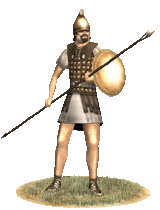 Pantodapoi Phalangitai are the standard levy of the Seleukidos Kingdom and others influenced by the Diadochoi, including Pontos. They are tough and reliable infantry, but are prone to rebellion and discontent, and are hence more expensive than their Makedonian contemporaries. They are mostly levies of Iudaioi, Syrioi, and Persai descent that are co-opted into the army. They fight as pikemen, with a soft leather cuirass, pikes, round Illyrian style shields and Phrygian caps. This makes them a viable pike unit, though they are less disciplined and more prone to flee than more reliable Hellenes and Makedonians that make up the Pezhetairoi. They can be counted upon to present a solid wall of spear points to the enemy, but their lack of discipline and intensive training makes them even more prone to a flanking attack. Pantodapoi Phalangitai are the standard levy of the Seleukidos Kingdom and others influenced by the Diadochoi, including Pontos. They are tough and reliable infantry, but are prone to rebellion and discontent, and are hence more expensive than their Makedonian contemporaries. They are mostly levies of Iudaioi, Syrioi, and Persai descent that are co-opted into the army. They fight as pikemen, with a soft leather cuirass, pikes, round Illyrian style shields and Phrygian caps. This makes them a viable pike unit, though they are less disciplined and more prone to flee than more reliable Hellenes and Makedonians that make up the Pezhetairoi. They can be counted upon to present a solid wall of spear points to the enemy, but their lack of discipline and intensive training makes them even more prone to a flanking attack.
Historically, the Seleukidoi and others used pike levies from their various subject peoples to make up parts of the battle line that were facing the enemy's least valuable troops. They gave decent accounts of themselves at many battles, but were the first line to break in the disasters at Raphia against the Ptolemies and in Makedonia against the Romaioi. They made up more and more of the Seleukidos battle line as time went on, due to the dwindling number of Hellene recruits that the army could draw upon for the pike units (most went to the more elite units), and more and more Asian peoples were put into the Pezhetairoi class and given land grants, to make up the loss, yet these more unreliable formations were still used in many places.
Hoplitai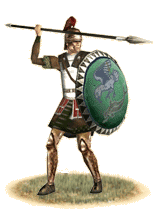 Even though the Makedonian phalangitai has become the dominant infantry type among the Hellenic powers, the hoplitai of old, those who fight in much the same manner as the Hellenes of Thermopylai, Marathon and Plataiai did, are still around defending their poleis. Each hoplites is equipped with linen or leather armor, an aspis shield, greaves, the attic style helmet and of course, his spear. Their equipment might have changed since the battles of a centuries past, but their tactics has not. The hoplitai still fight in the phalanx formation, often eight man deep whose purpose is to advance forward upon the enemy line, tie them and to whittle them down through attrition. Even though the Makedonian phalangitai has become the dominant infantry type among the Hellenic powers, the hoplitai of old, those who fight in much the same manner as the Hellenes of Thermopylai, Marathon and Plataiai did, are still around defending their poleis. Each hoplites is equipped with linen or leather armor, an aspis shield, greaves, the attic style helmet and of course, his spear. Their equipment might have changed since the battles of a centuries past, but their tactics has not. The hoplitai still fight in the phalanx formation, often eight man deep whose purpose is to advance forward upon the enemy line, tie them and to whittle them down through attrition.
Historically, the hoplites is one of the most famous types of soldiers that has ever existed. The Hellenic military ethos and culture from the 8th century and until the Roman hegemony created a highly skilled heavy infantryman. This combined with the phalanx formation, proved to be key factors in winning over the numerically larger Persian and barbarian armies of the day.
The hoplitai were mostly drawn from the well-to-do citizens of a polis, who often had a stake in the outcome of the battle or war to come, and who were bound to eachother by a patriotic feeling to their home city, creating a body of citizen-warriors whose motivation was unlike that of any levy, mercenary or other professional soldiers. The hoplites of the Hellenic city states continued to be the dominant infantry type on the battlefield for almost two centuries after the Persian Wars, but the appearance of the Peltastoi made them more vulnerable than before and highlighted the shortcomings of the phalanx, and the rise of Makedonia in the north and its phalangitai, became the decline of the "classical" hoplites being fielded in large numbers. However, variants of the hoplites were succesfully adapted by various Hellenic powers, like the Ekdromoi & Thorakitai Hoplitai. And even after the wars of Alexandros and those of his successors, some poleis and smaller communities still fielded contingents of hoplitai, who were trained and fought in the same fashion as the hoplitai of old.
Peltastai (Hellenic Heavy Skirmishers)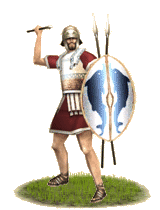 The Peltastai is a type of elite skirmisher that sacrifices heavy arms and armor for mobility and range. They are armored in linen and carry a medium sized ovular shield. Originally, they carried a crescent shaped 'pelta' shield, originated in Thrake and gave the peltastai their name, but this was phased out in the fourth century. Their armaments consist of several javelins and a sword. This panoply makes them light and mobile, but still able to engage in melee after their javelins have been thrown. They are a versatile unit but one must remember that their primary arms are javelins, and they are not equipped to stand toe to toe with heavier infantry. Their role is one of speed, harassment, and critical flanking maneuvers. The Peltastai is a type of elite skirmisher that sacrifices heavy arms and armor for mobility and range. They are armored in linen and carry a medium sized ovular shield. Originally, they carried a crescent shaped 'pelta' shield, originated in Thrake and gave the peltastai their name, but this was phased out in the fourth century. Their armaments consist of several javelins and a sword. This panoply makes them light and mobile, but still able to engage in melee after their javelins have been thrown. They are a versatile unit but one must remember that their primary arms are javelins, and they are not equipped to stand toe to toe with heavier infantry. Their role is one of speed, harassment, and critical flanking maneuvers.
Historically, the peltastai were often hoplitai or pezhetairoi equipped to fight in the manner of a skirmisher. This meant that they were adept melee combatants as well as being deadly with their javelins. Peltastai were used to great effect on ancient battlefields but by 270 BC the thureophoros was becoming the dominant melee skirmisher and the peltastai were carrying more javelins and were used in a manner that was consistent with this. This was simply a matter of specialization, and it did not mean that peltastai would be any less effective if deployed correctly. Their light armament makes them extremely fast, but tends to be to their detriment in melee combat. They were mostly used in the role of supporting missile troops who charged in at the last moment, after they had spent all their javelins. The great Athenian general Iphikrates is credited with the invention of the peltast as a distinct unit, and it is he that first employed them in this manner to great effect against the heavier armored and better trained hoplitai of Sparte.
Thureophoroi (Hellenic Spearmen)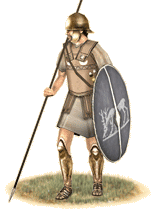 Thureophoroi were a new class of Hellenic infantry that was designed to both augment the phalanx and provide a type of soldier in between the phalangite and the peltastai that was able to both skirmish and fight in melee effectively. These men provide an extremely mobile force that can hit hard with their heavy javelins then rush in to flank pike units. They are well armed and armored for the task, having stout bronze helms, linen armor, an almond shaped thureos shield, heavy javelins, and a stout spear. They are highly versatile infantry, akin in spirit to the legionaries of Rome. They are a highly effective force of heavy infantry that is in the forefront of Hellenic military know-how. Thureophoroi were a new class of Hellenic infantry that was designed to both augment the phalanx and provide a type of soldier in between the phalangite and the peltastai that was able to both skirmish and fight in melee effectively. These men provide an extremely mobile force that can hit hard with their heavy javelins then rush in to flank pike units. They are well armed and armored for the task, having stout bronze helms, linen armor, an almond shaped thureos shield, heavy javelins, and a stout spear. They are highly versatile infantry, akin in spirit to the legionaries of Rome. They are a highly effective force of heavy infantry that is in the forefront of Hellenic military know-how.
Historically, Thureophoroi were used as harassing and flanking troops by the successor states. Though they were often described by Latin writers as copies of the legion, it is debatable whether they were developed with knowledge of warfare in Italy or not. Most Thureophoroi were Pezhetairoi, middle class property owners with voting rights, and as such, they were well able to devote time to training and practice and were highly disciplined and courageous troops. Despite their obvious advantages, or perhaps because of them, there was a lot of confusion as to how to utilize these new soldiers. As were deadly in the extreme to the less mobile phalanx units they forced a, much resisted, revaluation of Hellenic warfare. Perhaps for this reason the Diodachoi tended to used them conservatively, except for the Seleukidai, who took to these new soldiers quite well. The city-states of Hellas used them even more frequently against the armies of Makedonia, and were often able to hold the more powerful kingdom at bay. Still, their uses were limited in scope and not as widespread as their versatile and deadly role would have indicated. This is the fault of period commanders, however, and a more astute or innovative commander might have realized their potential in conjunction with the more static phalanx.
Klerouchoi Phalangitai (Hellenic Medium Phalanx)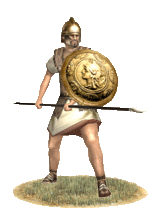 The Klerouchoi Phalangitai form the backbone of the Successor armies of Aigyptos and Asia, along with the less numerous Pezhetairoi. These men are given a plot of land or kleros, maybe some slaves and a tax reduction and in return they serve in the phalanx when called upon to war by their Basileus. They are citizens just as the Pezhetairoi, but they are citizens with-strings-attached, as they are required to fight when called upon or otherwise their livelihood might be taken away from them. The Klerouchoi Phalangitai form the backbone of the Successor armies of Aigyptos and Asia, along with the less numerous Pezhetairoi. These men are given a plot of land or kleros, maybe some slaves and a tax reduction and in return they serve in the phalanx when called upon to war by their Basileus. They are citizens just as the Pezhetairoi, but they are citizens with-strings-attached, as they are required to fight when called upon or otherwise their livelihood might be taken away from them.
Even though the phalanx is a Hellenic soldier formation, some Thraikes, Keltoi, Ioudaioi and other subjects were also given Klerouchos status to increase the number of Phalangitai available, but the main bulk of the Klerouchoi Phalangitai are still Hellenes. Each soldier is armed with the sarissa and wears a linen or leather cuirass, a Thracian helm, and a Makedonian pelte provided by the Basileus. In battle they are best deployed in a defensive posture, or in a slow but steady advance towards the enemy, grinding down their opponents' numbers through attrition, or to pin enemy formations so they can be flanked by other units.
The wars which followed the breakup of Megas Alexandros' empire drained the Makedonian armies of many of their Makedones. For the western Diadochoi, levies from populations could take place directly, but the eastern Diadochoi depended on their dwindling standing armies or on new mercenary recruits. They needed a renewable source of Hellenic recruits if they were to keep power and retain their military strength. As the pike-phalanx was the backbone of their armies, they needed Hellenes to fill its ranks. While mercenaries could temporarily fulfill such a need, their loyalty was never assured, while their demands for pay always were.
The answer was the establishment of Hellenic military-settlements throughout the Successor states, where a soldier was given a plot of land and reduced taxes. Sometimes they were given some slaves too, to work their alloted land, freeing up more time for the Klerouchos soldier to be on campaign. Arming the native population (Aigyptioi in the Ptolemaic kingdom, Syriakoi and Babylonioi in the Seleukid Empire), was less appealing, as that would have laid the Makedonian dynasties open for native revolts in their respective heartlands. In Aigyptos most Klerouchoi were settled in the Fayum depression, but many others were settled further to the south, though in smaller numbers.
Klerouchoi were also settled by the Ptolemaioi in settlements in Asia, Kypros, and Koile Syria, but nearly all Hellenic, Klerouchoi Phalangitai were settled in Aigyptos, and primarily in the Arsinoite and Herakleopolite nomes, in or near the Fayum. In the Arche Seleukeia these settlements, called Katoikiai, were established in western Asia around Sardis, throughout Syria and Mesopotamia, and as far away as Baktria and Paropamisadai. The Klerouchoi population in Aigyptos eventually deteriorated, and lost much of its martial character after the arrival of the Romans, while the Katoikiai in Seleukid regions, especially those in western Asia, passed into the hands of the Pergamenes first, then Pontos, and finally the Romaioi.
Lonchophoroi Hippeis (Hellenic Medium Cavalry)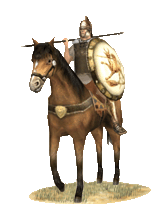 Hail Stratege! Fine noblemen forming a sturdy body of cavalry whose purpose is to crash into your foe and have the staying power to breach his line are here, arrayed before you. Armed with stout single handed lances and the mighty aspis of our ancestors, they can unleash a terrible charge. Once they have inflicted gruesome casualties on our enemies, they will switch to their melee weapon and begin a close-in slaughter. While men from Epeiros or Makedonia proper would have the sturdy Kopis, men further east may prefer the stout bladed war axe like that used by Alexander at the Granicus. They are armored with scale reinforced linen, greaves, and masked Phrygrian helmets that betray naught but the angry face of Zeus Pater or wrathful Poseidon. They are best used as a general purpose heavy cavalry. However, if facing the sturdier men from the east, or, Gods forbid, the elite Hetairoi or massive Kataphraktoi of the Seleukides and Baktrioi, they may not have the staying power that they would against other heavy cavalry. Use them well, and they will give your enemies naught but the death they so richly deserve! Hail Stratege! Fine noblemen forming a sturdy body of cavalry whose purpose is to crash into your foe and have the staying power to breach his line are here, arrayed before you. Armed with stout single handed lances and the mighty aspis of our ancestors, they can unleash a terrible charge. Once they have inflicted gruesome casualties on our enemies, they will switch to their melee weapon and begin a close-in slaughter. While men from Epeiros or Makedonia proper would have the sturdy Kopis, men further east may prefer the stout bladed war axe like that used by Alexander at the Granicus. They are armored with scale reinforced linen, greaves, and masked Phrygrian helmets that betray naught but the angry face of Zeus Pater or wrathful Poseidon. They are best used as a general purpose heavy cavalry. However, if facing the sturdier men from the east, or, Gods forbid, the elite Hetairoi or massive Kataphraktoi of the Seleukides and Baktrioi, they may not have the staying power that they would against other heavy cavalry. Use them well, and they will give your enemies naught but the death they so richly deserve!
Historically, the lancers of later Hellenistic armies were divided into several types. Some cavalry performed shock roles as a secondary function, with the charge itself being their goal, and thus it became necessary to develop a specific force of cavalry who could charge in suppport but lend staying power to their comrades. This sort of cavalry was used to great effect by the forces of Syrakousai and Taras in the west, Epeiros, Pergamon and Makedonia in the heartland of the Greek and Makedonian peoples, and the even the great Hellenistic kingdoms of Aigyptos, Syria, and Baktria. They appear on both sides at the battle of Magnesia, where they and the Pergamene Hetairoi checked the advance of more heavily armored Seleukid cavalry, allowing the Romans to roll up the line of Seleukid infantry. Still, they have some weaknesses, and should not be expected to defeat elite troops in prolonged battle.
Misthophoroi Uazali (Mercenary Karian Warband)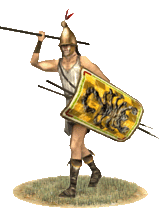 The Uazali are warbands of soldiers from the peoples of the southern coast of Mikra Asia: the Karians, Lykians, Pamphylians, and Pisidians. These warlike peoples have long traditions of military service abroad, and of nearly constant local warfare between the small cities and towns separated by the towering heights of the western Taurus. These Uazali are skilled mountain fighters. Their name comes from the Lykian tongue, and means "Warriors," and is similar also to the words used by the other peoples along the southern coast of Mikra Asia, all of whose languages derived primarily from the Hittite tongue. The Uazali carry a solid rectangular shield slung over the shoulder to ease the burden on the arms, emblazoned with signs of their peoples, and wear a solid Phrygian helm, a common form of protection among those in Asia who could afford such things. For weapons, they carry several javelins and a lengthened xiphos sword, which became a popular weapon in Mikra Asia, both as a result of the Iphikratid reforms, and out of experience fighting the Galatai, with their longswords. Their shields and helmets provide them a great deal of protection compared to most other skirmishing units, and their ferocity in melee surpasses most of their peers. The Uazali are warbands of soldiers from the peoples of the southern coast of Mikra Asia: the Karians, Lykians, Pamphylians, and Pisidians. These warlike peoples have long traditions of military service abroad, and of nearly constant local warfare between the small cities and towns separated by the towering heights of the western Taurus. These Uazali are skilled mountain fighters. Their name comes from the Lykian tongue, and means "Warriors," and is similar also to the words used by the other peoples along the southern coast of Mikra Asia, all of whose languages derived primarily from the Hittite tongue. The Uazali carry a solid rectangular shield slung over the shoulder to ease the burden on the arms, emblazoned with signs of their peoples, and wear a solid Phrygian helm, a common form of protection among those in Asia who could afford such things. For weapons, they carry several javelins and a lengthened xiphos sword, which became a popular weapon in Mikra Asia, both as a result of the Iphikratid reforms, and out of experience fighting the Galatai, with their longswords. Their shields and helmets provide them a great deal of protection compared to most other skirmishing units, and their ferocity in melee surpasses most of their peers.
Historically, many young men from Karia, Lykia, Pamphylia and Pisidia went overseas to serve as mercenaries, or were recruited in their native lands as militias and katoikoi for the successors. Many of the most Hellenized inhabitants joined the ranks of thureophoroi and other medium infantry units in other lands. Many others, however, stayed closer to their native infantry traditions, and served abroad as warrior bands, or as locally-recruited troops in their own lands. They were used to great effect in irregular mountain combat, but also distinguished themselves in assaults, and if they end up in the battle line in major pitched battle, a good commander will maximize their skirmishing and melee abilities by using them in a flanking, ambushing, or screening role if at all possible.
Galatikoi Kluddolon (Galatian Shortswordsmen)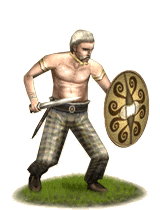 The Kluddolon (Klud-oh-lon; "Sword Bearers") make up a light levy of Galatian warriors. They are young, and fairly unreliable due to this. However, they part of the common levies that accompany Galatian chiefs; as such, mercenary Galatians would be accompanied by many men of this class of warrior. They are used as light, mobile warriors to hit in short strikes, or used on flanks. They were also historically used to break phalanxes. The Kluddolon (Klud-oh-lon; "Sword Bearers") make up a light levy of Galatian warriors. They are young, and fairly unreliable due to this. However, they part of the common levies that accompany Galatian chiefs; as such, mercenary Galatians would be accompanied by many men of this class of warrior. They are used as light, mobile warriors to hit in short strikes, or used on flanks. They were also historically used to break phalanxes.
Historically, Galatian mercenaries were very popular with any who could afford to hire them, and were also reputed as maruaders. The shortswordsmen were a valuable part of a Galatian force; they would be used to get under a phalanx and gut it before heavier soldiers would enter the breach and cut down the spearmen from within. As such, the seemingly very light, weak infantry could be a very feared part of a Galatian force. Their name is a from the Galatian Celtic; a form of Gallic with very overt Greek influences.
Galatikoi Lavotuxri (Galatian Heavy Cavalry)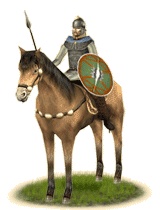 The Lavotuxri are cavalrymen, made up of young Galatian nobles and aristocrats of military age. They fight in the same manner as Gallic cavalry in Western Europe, although they wear tunics of brighter colors to better stand the Anatolian heat. They are equipped with Gallic-style chain mail, Gallic helmets and large round shields. They also carry Celtic longswords and spears. Their horses, if not stolen are imported from the steppes north the Pontos Euxine, Armenia or even Media. The Lavotuxri are good medium cavalry, well able to do their part on the battlefield as long as they are used in that role. The Lavotuxri are cavalrymen, made up of young Galatian nobles and aristocrats of military age. They fight in the same manner as Gallic cavalry in Western Europe, although they wear tunics of brighter colors to better stand the Anatolian heat. They are equipped with Gallic-style chain mail, Gallic helmets and large round shields. They also carry Celtic longswords and spears. Their horses, if not stolen are imported from the steppes north the Pontos Euxine, Armenia or even Media. The Lavotuxri are good medium cavalry, well able to do their part on the battlefield as long as they are used in that role.
Historically, the Lavotuxri were skilled cavalrymen and could often be found in service to the Successor states, but were most prominent in the armies of Pergamon and Pontos. The wars of the Hellenistic monarchies provided ample opportunity for the Galatians to seek their fortunes as mercenaries, and they were highly sought after. From the time they crossed into Anatolia until the battle of Actium, Galatians were involved in almost every major battle and war in the eastern Mediterranean.
Galatikoi Kuarothoroi (Galatian Heavy Spearmen)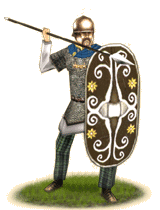 The Kuarothoroi were superb Galatian warriors that often fought for Pontos and Pergamum. Kuarothoroi are elite heavy spearmen recruited from among the Galatian tribes near the Pontic border. They form the vanguard of the shock infantry of both nations, and are well able to give a good account of themselves. They are armed and armoured to the teeth and are well able to serve as a disciplined and nearly fanatic shock infantry. They carry long spears and wield large shields which make them ideal flankers in the situation that they are deployed against phalanx units. Other than this, Kuarothoroi are well able to attack and defend against various types of soldiers, putting them among the most versatile heavy infantry. They are particularly deadly against cavalry. A smart commander will place these armoured troops where the battle is likely to be the hardest fought. The Kuarothoroi were superb Galatian warriors that often fought for Pontos and Pergamum. Kuarothoroi are elite heavy spearmen recruited from among the Galatian tribes near the Pontic border. They form the vanguard of the shock infantry of both nations, and are well able to give a good account of themselves. They are armed and armoured to the teeth and are well able to serve as a disciplined and nearly fanatic shock infantry. They carry long spears and wield large shields which make them ideal flankers in the situation that they are deployed against phalanx units. Other than this, Kuarothoroi are well able to attack and defend against various types of soldiers, putting them among the most versatile heavy infantry. They are particularly deadly against cavalry. A smart commander will place these armoured troops where the battle is likely to be the hardest fought.
Historically, Kuarothoroi were among the most 'Hellenized' of the Galatian warrior class and many took Greek or Persian wives and settled in new homelands on rich estates won by their superb military service to either nation. Their name derived from the Greek name kouros-kouretes which means young men of fighting age and therefore warriors.
Galatikoi Tindanotae (Galatian "Wild Men" Infantry)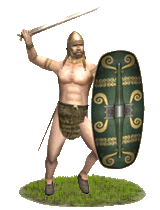 The Tindanotae (Ten-dan-ot-ay; "Wild/Mad Men") are the product of the dying tradition of naked Celtic warriors. They are fierce, brave to the point of insanity, and able to break even well disciplined formations with a furious charge, preceded by javelins. The Tindanotae can stand well in a melee, and their appearance is known to shake even the most experienced warriors. It is not unusual for Tindanotae to stand and fight until they are all dead, or their enemies run off, killed, or captured. The Tindanotae (Ten-dan-ot-ay; "Wild/Mad Men") are the product of the dying tradition of naked Celtic warriors. They are fierce, brave to the point of insanity, and able to break even well disciplined formations with a furious charge, preceded by javelins. The Tindanotae can stand well in a melee, and their appearance is known to shake even the most experienced warriors. It is not unusual for Tindanotae to stand and fight until they are all dead, or their enemies run off, killed, or captured.
Historically, Galatia still had warriors who fought nude. These warriors were generally older, more experienced fighters, with fanatical or murderous attitudes. Many may well have been truly insane or psychotic. It was not unusual for the Tindanotae to be religious fanatics. They favored devotion to Heracles, or traditional Gallic war gods like Teutatis; later, in severely reduced numbers due to Roman domination, they would be generally Christian fanatics. It was not unusual for the Tindotae to carve a name or symbol on their own body representing their chosen god. This manner of self mutilation was also left over from bygone days of Gaul, when men would scar themselves to show their strength.
Anatolikoi Phyletai (Anatolian Hillmen)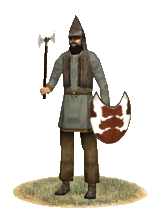 These troops are armed with a large axe, with a double, half-moon shaped blade called a Bipennis. They also use a wooden, crescent-shaped shield similar to the old Greek Pelte. They favour bright clothing and often paint their shields in garish colours. Their charges are dangerous for most enemies and even the stoutest armour will suffer from a blow of the weapons they wield. However, being lightly protected themselves protracted fighting will see their casualties mounting. These troops are armed with a large axe, with a double, half-moon shaped blade called a Bipennis. They also use a wooden, crescent-shaped shield similar to the old Greek Pelte. They favour bright clothing and often paint their shields in garish colours. Their charges are dangerous for most enemies and even the stoutest armour will suffer from a blow of the weapons they wield. However, being lightly protected themselves protracted fighting will see their casualties mounting.
Historically, the Anatolian highlands always featured axes in their warfare. The axe was the characteristic weapon of the infantry recruited there and they excelled in its use. The more civilized nations often suffered from attacks by the mountain tribes of Anatolia. Wise kings have put this to use, and these men are recruited from the native tribesmen who sell their warrior skills to the highest bidder.
Katpatuka Zanteush (Cappadoccian Hillmen)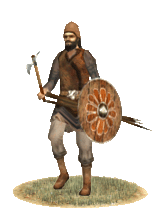 These fierce tribesmen come from the ancient land of Kappadokia, the Hittite, Katpatuka 'land of the beautiful horses'. The tribal warriors raised in the mountains of Kappadokia know the terrain and are well equipped, with javelin and axe, for mountain warfare. They will not do as well away from these heights, as they lack the heavier armour of the Greek infantry. Their axes and javelins will allow them to give a good account of themselves but heavy melee should be avoided. These fierce tribesmen come from the ancient land of Kappadokia, the Hittite, Katpatuka 'land of the beautiful horses'. The tribal warriors raised in the mountains of Kappadokia know the terrain and are well equipped, with javelin and axe, for mountain warfare. They will not do as well away from these heights, as they lack the heavier armour of the Greek infantry. Their axes and javelins will allow them to give a good account of themselves but heavy melee should be avoided.
Historically, while some of the tribes living in the mountains were hostile towards the Greeks, others cultivated very close relationships with them. It is from these mountain warriors the Tibareni and Chaldaei tribesmen, the Mossynoecians, Makrones and other tribes residing in the eastern part of Northern Anatolia, that the skirmishers of Pontos are recruited. the terrain of Pontos is well suited to the style of warfare these men are practiced at. The Pontic Alps stand as a wall between the interior plateau and the rich, narrow plain bordering the sea. These tribes ward the mountain approaches and the kings of Pontos know well the value of such friendship. Xenophon too found such frienship of great value in his passage of these regions. Many of these mountains are thoroughly impassable and altogether precipitous, and there are extensive areas devoid of human habitation, only plunging ravines from which it is impossible to climb out, forested heights and impassable chasms.
Katpatuka Asabara (Cappadocian Medium Cavalry)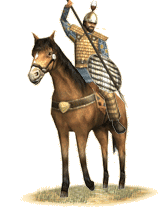 These Katpatuka Asabara provide Pontos with the mounted core of its army and are the shock arm of its cavalry. They ride to war in scale armour and shield, wielding spear and axe in the old Persian style. They form a reliable medium cavalry for which a good commander will find many uses. These Katpatuka Asabara provide Pontos with the mounted core of its army and are the shock arm of its cavalry. They ride to war in scale armour and shield, wielding spear and axe in the old Persian style. They form a reliable medium cavalry for which a good commander will find many uses.
Historically, Katpatuka Asabara comes from old Imperial Persian nobles that the Alexandrian conquest did not dispossess and still hold their old estates. The high cost of warhorse and gear required the revenues of landed nobility to be capable of affording service to the king. The excellent Median horse was raised in Kappadokia and provided the mounts for these men. Median horses were noted for their size and strength, although not particularly tall, about 14 or 15 hands. They had large heads and strong necks with most being chestnuts, browns or blacks. Persian horse manes were clipped short, like those of the mounted archers of other nations, so it would not interfere with the action of shooting. The tails were tied up to prevent it being grabbed by the enemy. The forelock was left long and tied with ribbon to form a plume above the head. The Kappadokian plain provided the grasslands and rich pastures needed for good quality cavalry and the Achaemenid Persians granted imperial estates throughout Anatolia for the raising of Satrapal cavalry forces. With the fall of the old Persian empire these men found themselves as lords of a new land, serving the Iranian dynasty of Pontos.
Nizakahar Ayrudzi (Armenian Skirmisher Cavalry)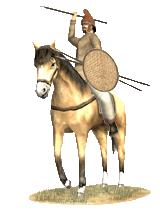 Ayrudzi, literally means "the horsemen". These light cavalry are well suited to the mountainous home of the Armenians. These are light cavalry, best used for a harassing role. Armed with a bundle of javelins and protected by a Taka shield, these horsemen have no armour, preferring to use speed to protect themselves. After they use up their javelins, they can close to fight with a spear, though they are really too lightly equipped to stand up to any save the lightest of troop types. While not as long ranged or as tough as Armenia’s nomadic neighbour’s, horse archers, they fill essentially the same role, and any Eastern general would certainly want to include them in their army. Ayrudzi, literally means "the horsemen". These light cavalry are well suited to the mountainous home of the Armenians. These are light cavalry, best used for a harassing role. Armed with a bundle of javelins and protected by a Taka shield, these horsemen have no armour, preferring to use speed to protect themselves. After they use up their javelins, they can close to fight with a spear, though they are really too lightly equipped to stand up to any save the lightest of troop types. While not as long ranged or as tough as Armenia’s nomadic neighbour’s, horse archers, they fill essentially the same role, and any Eastern general would certainly want to include them in their army.
Historically, Ayrudzi cavalry came from the poorer Azats (lesser nobles) and rich Ramiks (peasantry) of Armenia unable to afford better gear, but rich enough for mounted warfare, often a more prestigious service in Armenian armies.
Skuda Fistaeg Fat Aexsdzhytae (Scythian Foot Archers)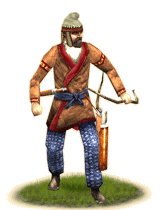 These Skythian archers often carry a slightly larger version of the composite bow that their fellow cavalrymen employ. This fact, together with the advantage of shooting from a more stable platform than a moving horse, tends to give their missiles somewhat longer range and more power than those typically shot by horse archers. To some extent, they compensate in this way for their comparative lack of mobility. Certainly, substantial numbers of foot bowmen can make sure that horse archers stay away from the area of the battlefield where they are deployed or inflict substantial damage on them, should they be foolish enough to engage in a protracted missile exchange. Of course, they will not be able to catch and destroy the elusive riders if the latter decide to avoid the arrow duel. In that regard, it is important that these archers are not lured too far away from supporting heavier infantry or cavalry whether in the pursuit of horse archers or for any other reason. They are not well outfitted for hand to hand combat, as all they carry is a short sword or small pickaxe and no armor but their thick jackets and bashlyk felt caps. If unsupported, they will be easy prey for cavalry, or aggressive infantry fast enough to catch them. These Skythian archers often carry a slightly larger version of the composite bow that their fellow cavalrymen employ. This fact, together with the advantage of shooting from a more stable platform than a moving horse, tends to give their missiles somewhat longer range and more power than those typically shot by horse archers. To some extent, they compensate in this way for their comparative lack of mobility. Certainly, substantial numbers of foot bowmen can make sure that horse archers stay away from the area of the battlefield where they are deployed or inflict substantial damage on them, should they be foolish enough to engage in a protracted missile exchange. Of course, they will not be able to catch and destroy the elusive riders if the latter decide to avoid the arrow duel. In that regard, it is important that these archers are not lured too far away from supporting heavier infantry or cavalry whether in the pursuit of horse archers or for any other reason. They are not well outfitted for hand to hand combat, as all they carry is a short sword or small pickaxe and no armor but their thick jackets and bashlyk felt caps. If unsupported, they will be easy prey for cavalry, or aggressive infantry fast enough to catch them.
Along their history, the Skythians of the northern coast of the Black Sea underwent a process of settlement and sedentarization. The phenomenon had started quite early, as Herodotos already spoke of farming Skythian groups, but it seems to have picked up pace as Sarmatian pressure pushed the Skythians out from much of their former lands and restricted them to a much reduced territory (the western part of the Crimea and the lower Dniepr) that could not have supported a large nomadic population. This process resulted in Skythian armies fielding increasing numbers of foot troops. A good portion of those seem to have been bowmen, as many settled Skythians still favored their traditional weapon.
Skudra Tabari (Scythian Axemen)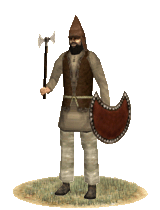 Armed with a Tabar axe, the primary offensive weapon of these infantrymen, they are protected with only the crescent shaped Taka shield and light armour. While unable to hold against most steppe cavalry, they can do deadly damage to some of the more “civilized” people’s inferior cavalry. But they would not last long against those same people’s massed heavy infantry. Despite some of their shortcomings, any steppe general would think twice before fighting a long campaign without these soldiers. Armed with a Tabar axe, the primary offensive weapon of these infantrymen, they are protected with only the crescent shaped Taka shield and light armour. While unable to hold against most steppe cavalry, they can do deadly damage to some of the more “civilized” people’s inferior cavalry. But they would not last long against those same people’s massed heavy infantry. Despite some of their shortcomings, any steppe general would think twice before fighting a long campaign without these soldiers.
Historically, despite all steppe peoples reliance on cavalry, most of them fielded infantry of some type at one time or another. In the case of the Scythians of the Pontic steppe, axemen were either recruited from subject farming peoples or from the growing proportion of settled Scythians, often young warriors from the tribes.
Doryphoroi Pontikoi (Pontic Light Spearmen)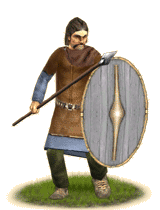 Doryphoroi Pontikoi are raised from peoples that live around the Azov Sea and the northern coast of the Black Sea and that have been subject to substantial Greek influence. This includes both original sedentary Maeotic and Sind tribes, settled groups of former nomads such as Scythians or the Sarmatian Siracae and also the Greek towns of the area. The non-Greek populations of the region have been long subject to substantial Greek influence, which is quite evident in, for example, the large oval shields of the thureos type that these infantrymen carry. That shield is typically their only protection. To it, they add spears and short swords. Thanks to their shields, they may face the many archers that their potential enemies are likely to field with some confidence and their spears allow them to fend off the light cavalry that is also common among their foes. They will also hold their ground against infantry similar to themselves. However, truly heavy cavalry, not to mention quality heavy infantry will get the better of them sooner rather than later. Doryphoroi Pontikoi are raised from peoples that live around the Azov Sea and the northern coast of the Black Sea and that have been subject to substantial Greek influence. This includes both original sedentary Maeotic and Sind tribes, settled groups of former nomads such as Scythians or the Sarmatian Siracae and also the Greek towns of the area. The non-Greek populations of the region have been long subject to substantial Greek influence, which is quite evident in, for example, the large oval shields of the thureos type that these infantrymen carry. That shield is typically their only protection. To it, they add spears and short swords. Thanks to their shields, they may face the many archers that their potential enemies are likely to field with some confidence and their spears allow them to fend off the light cavalry that is also common among their foes. They will also hold their ground against infantry similar to themselves. However, truly heavy cavalry, not to mention quality heavy infantry will get the better of them sooner rather than later.
Historically, by the 3rd century BC oval shields with long spines and spindle-shaped bosses spread and became common into the areas around the north coast of the Black Sea. The whole region had long maintained strong connections with the Greek world and this particular process followed military developments in the Hellenistic world. Infantry men equipped with oval shields and spears became common among the diverse ethnic groups that inhabited the region and for several centuries they formed part of the armies of a variety of nations including the Pontic and Bosporan kingdoms, Scythians and Sarmatians, Greek colonies of the area and Armenia.
Thureopherontes Toxotai (Bosphoran Heavy Archers)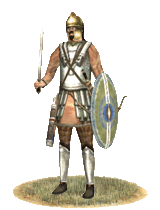 These soldiers are the epitome of Skythian and Hellenic fusion. While they wear Hellenic armour: a thureos shield, greaves, and Attico-Thracian helmet, their arms are Skythian: a bow and gorytos, and a Skythian longsword. They are among the wealthiest of the "Hellenized" class, able to afford multiple pieces of very expensive equipment, and are only eclipsed by the cavalry soldiers. They have trained extensively in archery, a tradition handed down among many on the north coast of the Pontos Euxeinos, and so may be expected to perform admirably against other missile units, few of which can match their armor level. Yet they are also well able to engage in melee, though a strategos would be unwise to send them to battle against fresh professional soldiers zealous for hand-to-hand combat.
Historically, the Bosporan Basileis, and the Pontic Basileis when they came to the north shores of the Euxeinos, desperately needed effective weapons against the skirmishing cavalry of the steppes. Foot archers were effective, but with their lack of armor, many of them were very much susceptible to both missiles and charges. The heavily-armed and armored archers are attested in both kingdom's armies through grave steles, and demonstrate the fusion between Hellenism and other cultures which characterized the social and military developments of the regions outside of the "traditional" Hellenic sphere. These soldiers are the epitome of Skythian and Hellenic fusion. While they wear Hellenic armour: a thureos shield, greaves, and Attico-Thracian helmet, their arms are Skythian: a bow and gorytos, and a Skythian longsword. They are among the wealthiest of the "Hellenized" class, able to afford multiple pieces of very expensive equipment, and are only eclipsed by the cavalry soldiers. They have trained extensively in archery, a tradition handed down among many on the north coast of the Pontos Euxeinos, and so may be expected to perform admirably against other missile units, few of which can match their armor level. Yet they are also well able to engage in melee, though a strategos would be unwise to send them to battle against fresh professional soldiers zealous for hand-to-hand combat.
Historically, the Bosporan Basileis, and the Pontic Basileis when they came to the north shores of the Euxeinos, desperately needed effective weapons against the skirmishing cavalry of the steppes. Foot archers were effective, but with their lack of armor, many of them were very much susceptible to both missiles and charges. The heavily-armed and armored archers are attested in both kingdom's armies through grave steles, and demonstrate the fusion between Hellenism and other cultures which characterized the social and military developments of the regions outside of the "traditional" Hellenic sphere.
Bydirag Baexdzhyntae (Steppe Riders)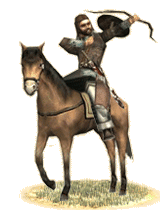 The Bydirag Baedxzhyntae (Steppe Riders) are light horsemen and are often found in the employ of settled nations. Light cavalry such as this is designed for scouting, screening your army, disrupting an enemy’s formation, wearing his morale and numbers through archery and, eventually, pursuit. The weapons that they use are the bow and arrow, but they also carry spears and small shields. In a pinch, they can be used for shock action, but this will yield poor results against unbroken infantry. They are trained in archery from childhood and ride with ease and grace atop their small, but trusty steppe pony. The Bydirag Baedxzhyntae (Steppe Riders) are light horsemen and are often found in the employ of settled nations. Light cavalry such as this is designed for scouting, screening your army, disrupting an enemy’s formation, wearing his morale and numbers through archery and, eventually, pursuit. The weapons that they use are the bow and arrow, but they also carry spears and small shields. In a pinch, they can be used for shock action, but this will yield poor results against unbroken infantry. They are trained in archery from childhood and ride with ease and grace atop their small, but trusty steppe pony.
Historically, mounted archers came from the steppes north and east of the Black Sea. They formed the bulk of the armies of different groups of what are broadly called “Iranian nomads”, but, as they expanded, their paticular methods of warfare, together with other aspects of their culture, were transmitted to other peoples. Thus horse archer like the Bydirag Baedxzhyntae were also present among, for example, the diverse peoples that dwelled on the European Caucausus and its neighboring areas. The settled powers to the south, such as Pontos and Armenia, valued greatly these mounted warriors and, caring little for their precise ethnic adscription, included then in their armies as either mercenaries, subjects or allies whenever they had the chance.
Skuda Uaezdaettae (Scythian Noble Cavalry)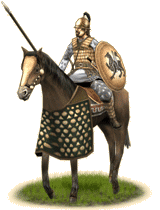 Although no longer the epitome of nomadic military ardor, the remnants of the Skythian nobility still serve as a powerful cavalry force. Now, the Skuda Uaezdaettae, or Skythian Nobles, fight in a matter almost more similar to the Greeks than their nomadic ancestors, preferring the xyston or spear and sword to archery, even though they still carry composite bows. Equipped with a fine lynothorax reinforced with metal scales, long pteryges and a Greek style bronze helmet, they can still form a deadly cavalry force, though not to the extent they once could. Their tactics have also shifted to deal more with similarly equipped cavalry and heavy infantry rather than nomadic horse archers. Although no longer the epitome of nomadic military ardor, the remnants of the Skythian nobility still serve as a powerful cavalry force. Now, the Skuda Uaezdaettae, or Skythian Nobles, fight in a matter almost more similar to the Greeks than their nomadic ancestors, preferring the xyston or spear and sword to archery, even though they still carry composite bows. Equipped with a fine lynothorax reinforced with metal scales, long pteryges and a Greek style bronze helmet, they can still form a deadly cavalry force, though not to the extent they once could. Their tactics have also shifted to deal more with similarly equipped cavalry and heavy infantry rather than nomadic horse archers.
Historically, after the Sauromatae began to invade their territory, the Skythians began to decline. Each year they shrunk, until they only continued in what became known as "Skythia Minor", the lower Dniepr and the Crimea. Because of this, their conections to the Hellenistic Black Sea colonies, which were always strong grew even greater until many Skythians were settled and resembled Greeks more than their nomadic cousins still on the steppe. Even so, they never completely lost their skill with cavalry and their martial prowess and under the rule of King Skiluros the Crimean Skythians experienced a revival of their fortunes. They gained control of the Greek city of Olbia and fought successfully against the Bosporan Kingdom. However, this prompted the intervention of a Pontic Kingdom that, under a young Mithradates VI was starting an agressive expansion. Pontic forces defeated the Skythians and made them vassals of Pontos. As such, they would become a very valuable asset for the Pontic army in its subsequent wars with Rome.
Pontikoi Thorakitai (Pontic Elite Infantry)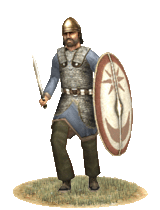 The Thorakitai represent the second evolution of the concept of the Theurophoroi, and show definite influence by the Romaioi in their implementation. They are armored in mail and carry heavy javelins instead of the lighter javelins carried by the Thureophoroi. Showing a clear Eastern influence and being mainly made up of non-Hellenes, the Pontic conception of the Thorakitai also have trousers and more cloth to cover exposed areas. They are more expensive and less mobile than their more lightly armored companions, but make excellent shock troops for the Pontic army. They are best utilized on the flanks of the phalanx to either flank the enemy while the phalanx pins them, or prevent enemy flankers from attacking the phalanx’s vulnerable flanks, although they can also fare relatively well as line infantry in the Roman fashion. They are best used in combination with the lighter Thureophoroi, who can support them with extra javelins and more importantly, speed, to make sure they are not surrounded. The Thorakitai represent the second evolution of the concept of the Theurophoroi, and show definite influence by the Romaioi in their implementation. They are armored in mail and carry heavy javelins instead of the lighter javelins carried by the Thureophoroi. Showing a clear Eastern influence and being mainly made up of non-Hellenes, the Pontic conception of the Thorakitai also have trousers and more cloth to cover exposed areas. They are more expensive and less mobile than their more lightly armored companions, but make excellent shock troops for the Pontic army. They are best utilized on the flanks of the phalanx to either flank the enemy while the phalanx pins them, or prevent enemy flankers from attacking the phalanx’s vulnerable flanks, although they can also fare relatively well as line infantry in the Roman fashion. They are best used in combination with the lighter Thureophoroi, who can support them with extra javelins and more importantly, speed, to make sure they are not surrounded.
Historically, the Thorakitai were used much like the Thureophoroi, but more rarely and later on. Unlike the Thorakitai soldiers of the Hellenic armies, the majority of the Pontic Thorakitai were not Hellenic middle-class property owners, but drawn from various subject peoples of Pontos or hired mercenaries, such as Thracians, Galatians, Bosphorans and hellenized Anatolians, all who were influenced by Hellenic military traditions and arms.
They alongside the Thureophoroi were probably what the Roman writers called ‘imitation legionnaires’ who were raised before the Third Mithradatic War as a response to the Roman legions. However, it is more likely that troops like these fought in Pontic armies much earlier on and it was after his defeat during his first war with Rome, that Mithradates VI Eupator vastly increased the number of Thorakitai-type troops in his armies due to the ineffectiveness of the Pontic pike phalanxes versus the Roman legionary cohorts, yet the Phalangitai still remained in Pontic armies, although of lesser importance. However, the newly raised "Pontic legions" were mostly made up of freed slaves and "Phalangitai-turned Thorakitai", however unlike before they were more heavily armored and underwent extensive training. Still it did not help him in the remaining wars, although the 'imitation legionaries' did fare surprisingly well considering their backgrounds and short training compared to their "Roman counterparts." Thorakitai soldiers like these could have been raised earlier than the time of the Mithradatic Wars as military innovations and trends did spread in the Hellenic world, a world which Pontos was part of.
Chalkaspidai (Pontic Elite Phalanx)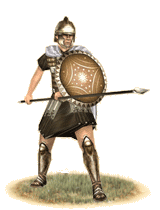 The Chalkaspidai (Bronze Shields or "brazen shields") are the elite phalangitai of the multicultural Pontic Kingdom, drawn from all quarters of local Hellenic and Hellenistic peoples, generally with varied backgrounds - though their name likens them to the great veteran phalanx of Megas Alexandros himself. Though not the same superb force, they can be a powerful and dangerous weapon in the hands of a competent general, but are less then useless in the hands of a fool. Their service role is best restricted to that of a part-time conscript, serving during the summer campaigns, but released at harvest or famine will follow. Their formation, the phalanx, is the traditional Hellenic infantry formation of a part-time citizen levy, passionately dedicated to their own local civic life. Known to have been used on occassion in ancient Sumeria, it is at its simplest, a compact body of spearmen, formed up in depth to present a hedge of spears to any attacker. The weak point of the phalanx is the flanks and if the enemy is able to engage the flanks then the formation will quickly fall into disorder. The sarissa is a clumsy weapon, not well suited to close quarters combat, but such is not its purpose. It is meant to be an impenetrable wall of pikes, creating a moving fortress from which cavalry can launch strikes, rolling up their enemies wings or exposed center. Vital to the success of the Pontic Chalkaspidai are light hoplites, hypaspistai, or even experience Persian light infantry stationed to guard the vulnerable flanks of the greater phalanx, though a strategic cavalry charge is their best compliment - completing the lethal hammer and anvil maneuver of the old Makedonian army. The Chalkaspidai (Bronze Shields or "brazen shields") are the elite phalangitai of the multicultural Pontic Kingdom, drawn from all quarters of local Hellenic and Hellenistic peoples, generally with varied backgrounds - though their name likens them to the great veteran phalanx of Megas Alexandros himself. Though not the same superb force, they can be a powerful and dangerous weapon in the hands of a competent general, but are less then useless in the hands of a fool. Their service role is best restricted to that of a part-time conscript, serving during the summer campaigns, but released at harvest or famine will follow. Their formation, the phalanx, is the traditional Hellenic infantry formation of a part-time citizen levy, passionately dedicated to their own local civic life. Known to have been used on occassion in ancient Sumeria, it is at its simplest, a compact body of spearmen, formed up in depth to present a hedge of spears to any attacker. The weak point of the phalanx is the flanks and if the enemy is able to engage the flanks then the formation will quickly fall into disorder. The sarissa is a clumsy weapon, not well suited to close quarters combat, but such is not its purpose. It is meant to be an impenetrable wall of pikes, creating a moving fortress from which cavalry can launch strikes, rolling up their enemies wings or exposed center. Vital to the success of the Pontic Chalkaspidai are light hoplites, hypaspistai, or even experience Persian light infantry stationed to guard the vulnerable flanks of the greater phalanx, though a strategic cavalry charge is their best compliment - completing the lethal hammer and anvil maneuver of the old Makedonian army.
Historically, Makedonian conquests never included Pontos, but their influence in tactics and military practices found a home on the shores of the Pontos Euxine and the phalanx was promptly adopted by Pontic generals and kings. Like the other latter day Hellenic states, Pontos tended to forget the nature and vulnerabilities of many of their phalanx pikemen, abandoning the highly effective cavalry tactics that had been developed to compliment them or relying to heavily on a weaker battle line. When commanders attempted to use them as a purely offensive arm, they failed to achieve anything, though their leader's lack of creativity or intelligence was more to blame then their skill - which was remarkable.
Khűveshâvagânę Shâhvâr (Pontic Early Bodyguards)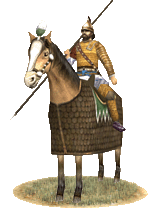 The Khűveshâvagânę Shâhvâr used to be the most expensively attired cavalry in the world, and were indeed the sign of the equestrian power of the Achaemenid world order. With the coming of Macedonian cavalry tactics, the Khűveshâvagânę Shâhvâr have undergone several changes. The final product is an extra-heavy cavalry unit, magnificently equipped with the finest technology mustered by the Achaemenids and their successors in Hayasdan and Pontos. Financed by the royal treasuries, they have been made into a contingent of specific honour, The Kinsmen. Armed with a xyston, and a machaira or mace along with the deployment in column formation, this unit is purely equipped for melee combat, like the later cataphracts. The mount being barded with peytrel, chamfrôn and the parameridia or armoured saddle, make this unit a particularly headstrong opponent worthy of respect. The Khűveshâvagânę Shâhvâr used to be the most expensively attired cavalry in the world, and were indeed the sign of the equestrian power of the Achaemenid world order. With the coming of Macedonian cavalry tactics, the Khűveshâvagânę Shâhvâr have undergone several changes. The final product is an extra-heavy cavalry unit, magnificently equipped with the finest technology mustered by the Achaemenids and their successors in Hayasdan and Pontos. Financed by the royal treasuries, they have been made into a contingent of specific honour, The Kinsmen. Armed with a xyston, and a machaira or mace along with the deployment in column formation, this unit is purely equipped for melee combat, like the later cataphracts. The mount being barded with peytrel, chamfrôn and the parameridia or armoured saddle, make this unit a particularly headstrong opponent worthy of respect.
With the fall of Persia proper the Khűveshâvagânę Shâhvâr who once served Achaemenid throne can no longer be called "Royal", in the mountains of the Caucasus and the foothills of Kappadokia, the Kingdoms of Hayasdan and of Pontos still maintain far smaller contingents of these devestating cavalrymen to serve as personal bodyguards to their Kings and Princes. Heavily influenced by Persian technology and military training, these heavy cavalrymen still equip themselves in the style of those "Kinsmen" of Achaemenid Persia. Armed with a xyston and a machaira or mace this full-contact unit can mount a terrible charge, wreaking havoc upon the enemy and additionally being clad entirely in bronze and the horse being armoured with an exotic combination of chamfrôn, peytrel and the parameridia, it must certainly have been a most impressive unit, both an ornament to whomever affording these warriors and a fearsome enemy. However, the Kingdoms of Hayasdan and Pontos cannot claim at all to be as rich as their Achaemenid predecessors and thus the numbers of these royally funded cavalry are small indeed; they can only be maintained as the personal bodyguards of the men of the Royal Houses of both Kingdoms. Yet even in such small numbers these men and their horses are devestating upon the battlefield, able to turn the tide of the battle with a single charge. Truly these are warriors to contend with!
Historically, the late Achaemenian heavy cavalry was an amalgam between Iranian horsemanship and an increasingly higher need for resilient and headstrong cavalry for shock tactics. Chariots, in particular scythed were most fearsome with a ample support, specifically heavy cavalry. The cavalry reforms of the latter half of the 5th century reached its apex during the patronage of the Persian Commander-in-Chief Pharnabazus, distinguished through Xenophon as a capable general, where the Persian "Cuirassiers" were not lined up for close combat but rather organized in columns for a sustained momentum in a charge. In accordance with the relief of Bozkir and some clear depictions of a parameridia (The armoured saddle), and earlier mention of horse armour in the form of peytrel and chamfrôn (As a nose-plate), this cavalry must have been quite heavily armoured. This cavalry, other than being depicted as the bodyguard of Cyrus The Younger during the civil war of Achaemenid Persia, was about to get a second overhaul, a step closer to the heavily armoured cataphracts of later Iranian dynasties. By then, the Persian army was beginning to become more Hellenized, which included certain Greek sabres.
During 372 BCE, Datames replaced Pharnabazus as the Commander-in-Chief of the Persian armies, and other than being accredited for the concept of a Persian hoplite'esque troop type, the Cardaces, Xenophon in his written work "Horsemanship", does not only recommend the parameridia, but also lauds an invention called "The arm", a very possible and likely addition of laminated armour, or as they are called in Greek, the "cheires". It is often suggested that Seleucid heavy cavalry came to adopt the banded/laminated armour for the arms from the Achaemenians. However, before the demise of the Achaemenians, a third reform was made during the reign of Darius III Codomannus, after the battle of Issus. Modelled after previous Achaemenid as well as Bactrian style armour, and combined Sakae and Macedonian cavalry tactics, the Hűvakâ of Darius was an interesting, but nonetheless fearsome amalgam. By the end of the Achaemenid dynasty, the Persians had two types of shock cavalry, the most popular undoubtly the scythed chariot often pulled by armoured horses and lead by heavily armoured crew. The second being an exotic variety of extra-heavy cavalry, household but also recruited from the Bactrians, Massagetae, Sakae, Cappadocians, Armenians and even westernly Scythians. The interesting aspect is that instead of completely relying on local traditions, the Achaemenians pursued their own reforms of the heavy cavalry. While for most of its lifespan being more of a extra-heavily armoured skirmisher cavalry with the ability to mount a charge in column formation, it evolved into a unit meant for full contact. It was aptly named the "Hűvakâ", meaning "The Kinsmen", something translated by Pahlavî as "xwesawand" or "Khűveshâvagân".
Naturally this would also require not only great physique and vigour of the mountee, but the requirements of the mount would be more strict as well. A horse, able to support a heavily armoured rider and some barding needed to be heavy-boned, tall, and muscular. Historically, by the end of the Achaemenian era, Persian emperors were given tribute, often in the form of horses. Cyrus The Great himself valued horses besides good weapons and chariots, as quoted from Herodotus. The main breeds for heavier cavalry were the Cappadocians, as earlier trained to serve as mounts for the famed Lydian lancers and subsequently the Perso-Hellenic kingdom of Pontus, as well as the Armenian horses known for their resilience, and finally the Mede and Parthian (Nisaean) breeds, in which especially the latter was not only known as perhaps the bulkiest of horses but also remarkably speedy, said to outrun the Iberian horses used by the Romans. Therefore it would seem that Achaemenian cavalry tradition formed the basis of subsequent Armenian and Pontic heavy cavalry, as well as providing the Seleucids with a vast range of not only heavy cavalry auxiliaries but also a variety of mounts. The Armenians and the Persian nobles of Pontus, being greatly influenced by Persian trends would most certainly have continued the tradition.
As a means of support for chariots, it could facilitate the sheer violence of the chariot charge as written by Xenophon: "The soldiers had got into the habit of collecting their supplies carelessly and without taking precautions. And there was one occasion when Pharnabazus, with 2 scythed chariots and about 400 cavalry, came on them when they were scattered all over the plain. When the Greeks saw him bearing down on them, they ran to join up with each other, about 700 altogether; but Pharnabazus did not waste time. Putting the chariots in front, and following behind them himself with the cavalry, he ordered a charge. The chariots dashing into the Greek ranks, broke up their close formation, and the cavalry soon cut down about a hundred men. The rest fled and took refuge with Agesilaus, who happened to be close at hand with the hoplites." (Xenophon Hellenica IV,1,17-19)
Pontikoi Strategoi (Pontos Late Bodyguard)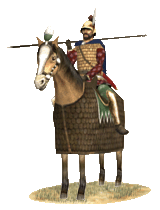 The King of Pontos and his kin ride to war with the finest horsemen in the realm as retainers, handpicked for their bravery, equestrian skills and social standing. Only the richest men in the kingdom can afford the expensive weapons and armor, or set out on campaign with the finest warhorses gold can buy. The cavalrymen themselves are drawn from the Hellenic nobility in the poleis under Pontic rule or from hellenized subjects, like Kappadokians, Galatians or Anatolians. The bodyguards are modeled after the famed Hetairoi or Companions of Megas Alexandros himself, whom the Pontic Kings wish to emulate. The riders themselves are armed with the lances & swords and wear Hellenic heavy armor, while their mounts are fully covered in armor, showing a clear influence from Armenian or Hellenic cataphracts. The King of Pontos and his kin ride to war with the finest horsemen in the realm as retainers, handpicked for their bravery, equestrian skills and social standing. Only the richest men in the kingdom can afford the expensive weapons and armor, or set out on campaign with the finest warhorses gold can buy. The cavalrymen themselves are drawn from the Hellenic nobility in the poleis under Pontic rule or from hellenized subjects, like Kappadokians, Galatians or Anatolians. The bodyguards are modeled after the famed Hetairoi or Companions of Megas Alexandros himself, whom the Pontic Kings wish to emulate. The riders themselves are armed with the lances & swords and wear Hellenic heavy armor, while their mounts are fully covered in armor, showing a clear influence from Armenian or Hellenic cataphracts.
Historically, cavalry like these evolved when Pontos became a large kingdom and had a large wealthy nobility to draw troops from. The Pontic Kings took great care to portray themselves as true Philhellenes and statues in Rhodes & Delos were erected of them. Mithridates VI Eupator emulated Alexander the Great in many ways and it is very likely that his predominantly Hellenic cavalry retainers wore armor comparable to that of both Alexandrian and contemporary Companion cavalry.
|
 |
|
 |






















|